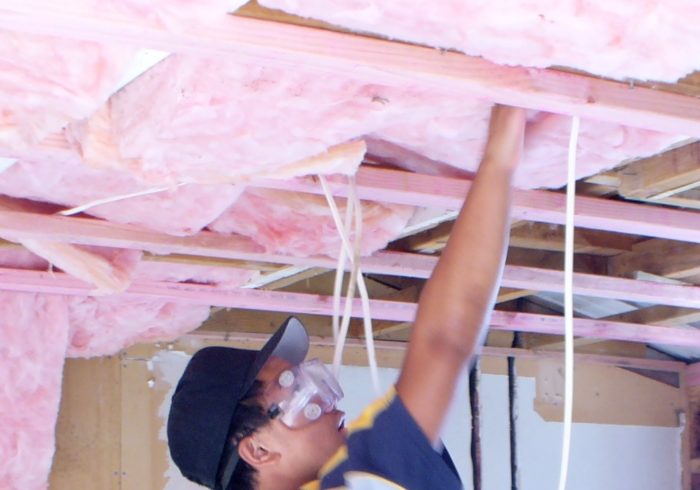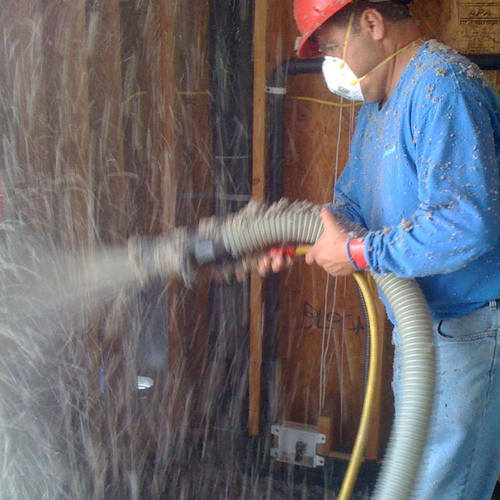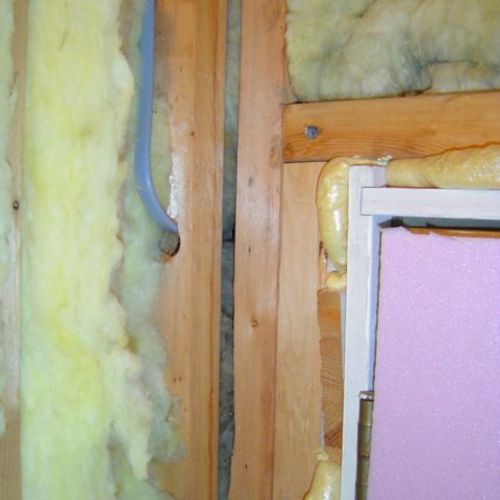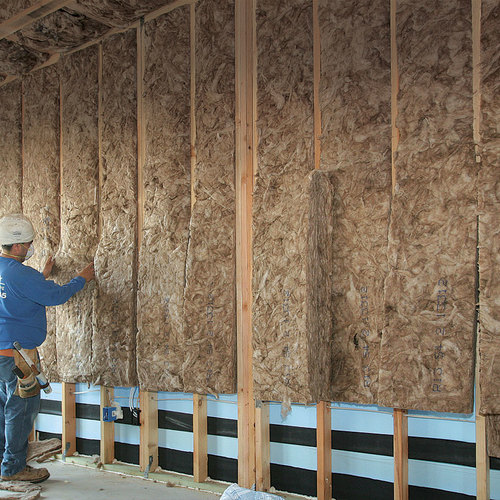The two least expensive and most commonly used residential insulation are fiberglass and cellulose. Granted, fiberglass is about 50 times more common — but a distant second is still second.
Unless the homeowner opts for spray foam, the insulation choice usually comes down to fiberglass vs. cellulose. So what are the advantages and disadvantages of each one? How are they similar and how are they different?
At first blush, itchy pink fiberglass and fluffy gray cellulose seems quite different. But the two types of insulation wouldn’t be competing for the same share of the housing insulation market if they weren’t in many ways alike.
Similarities
Cost: First off, both cellulose and fiberglass are inexpensive. Among the wide range of available insulation materials — including XPS foam board, EPS, polyisocyanurate, rock wool, and spray foam — cellulose and fiberglass are, inch for inch and square foot for square foot, the least expensive.
Of course, prices can vary from contractor to contractor, and may vary if you have access to a special deal, but in general, fiberglass batts and cellulose are usually the cheapest insulation options.
Ease of Installation: Fiberglass has become the most popular insulation in the world because it is effective (if properly installed) and inexpensive. Contractors and do-it-yourself folks don’t need special training or equipment to install it. (However, inexperienced installers often do a sloppy job of installation, reducing the effectiveness of the insulation job.)
When installed in an attic, blown-in cellulose requires about 3 molecules more effort. The job requires an insulation blower and 30 minutes of training from the guy at Lowe’s. (An important note: I am talking about blown-in cellulose here… not damp-spray, netted, or dense-packed cellulose.)
R-value: Fiberglass batts and cellulose deliver comparable R-value (between 3.5 and 3.7 per inch). This can vary based on many factors, including settling, wind-washing or outside temperature, but in general the R-values of the two products are similar.
Air leakage: Both types of insulation help retain heat, but neither one can act as an air barrier. Both cellulose and fiberglass allow air to pass through and need to be paired with an air barrier. The effective R-value of fiberglass can be particularly affected by air flow.
Moisture: Neither insulation is a fan of moisture. Both cellulose and fiberglass can retain large amounts of moisture. Because of their high air permeability both can dry out very quickly.
Cellulose and fiberglass are fibrous insulation which can easily trap moisture. If paired with a vapor barrier in a high moisture environment like your basement … it can be problematic.
Wind washing: Lastly, when blown onto the floor of an attic with vented soffits, both loose-fill cellulose and fiberglass are susceptible to wind.
A strong gust of wind will blow loose insulation all over the attic. With Maine’s stiff sea breezes, I’ve seen several houses whose insulation is blown entirely to one side. Loose-blown insulation requires properly sealed and blocked eaves to prevent wind washing.
Differences
Air leakage: It’s true that neither insulation is an air barrier. Neither cellulose (even when dense-packed) nor fiberglass meet any technical standard for an air barrier. However, cellulose will slow air flow whereas fiberglass does not.
When dense packed into a wall cavity, cellulose prevents most air flow. Even loose-fill cellulose slows some air movement.
Flammability: Fiberglass and cellulose have different issues with fire and flame spread. Fiberglass is spun glass; it won’t burn at any normal temperature. Under direct flame, it will simply melt. However, most fiberglass batts are faced with kraft paper which most certainly will burn.
Cellulose is ground-up paper. Very early cellulose-style insulation was quite flammable. (I mean, c’mon — it’s paper.) During the ’70s and ’80s, cellulose couldn’t shake a bad reputation stemming from (possibly apocryphal) stories about insulation fires.
Modern cellulose is heavily treated (about 15% by volume) with boric acid, borax nitrate or ammonium sulfate. [Editor’s note: see Daniel Lea’s 3/8/2012 comment on this point below.] These chemicals aren’t harmful to people, but are very effective flame retardants and help reduce pest issues. Modern cellulose manufacture has sufficiently high production standards that product quality and flammability are no longer issues of concern.
Ease of installation: Anyone can insulate a wall with fiberglass batts. It’s just a matter of cutting around electrical outlets, slapping the batts into the wall cavities and stapling the facing to the studs. Unfortunately, a fast, sloppy installation usually results in voids or imperfections. Proper installation of fiberglass batts is slow, meticulous work (which is why most fiberglass batt installations are fast and sloppy.)
Fortunately, it’s harder to do a sloppy job with cellulose, although installing cellulose in a wall requires special equipment like high-powered insulation blowers which are a sight more powerful than the Geo Metro versions you can rent at the Big Box store. Also, unless you like blowing out your finish drywall, more than a little experience is helpful.
Embodied energy: Embodied energy is the sum of energy required for a project or material. Fiberglass has a much higher embodied energy than cellulose insulation. Fiberglass is glass that is melted and spun into fibers like cotton candy. There are fiberglass brands which use recycled content but more often they use new raw materials.
Most cellulose brands use a high recycled content and the production process (shredding paper and adding fire retardant borates) uses much less energy.
Extreme cold: Last, the two types of insulation react very differently in extreme cold. During very cold weather — the type of weather sometimes seen in Minnesota or Maine — heat is quickly stripped from fiberglass insulation, and the R-value of fiberglass insulation drops. Cellulose doesn’t suffer as acutely from this problem.
Which insulation should you choose?
So should you insulate with cellulose or fiberglass? Well, I’ve included a photo showing insulation being installed at my house. (Click Image 2 below to see the photo.)
We dense-packed the wall cavities with cellulose. I choose cellulose because of the better air sealing, and comparable R-value for the same price. Should you insulate with cellulose or fiberglass? It depends on the project at hand.
Weekly Newsletter
Get building science and energy efficiency advice, plus special offers, in your inbox.
















13 Comments
A few points:
1). Fiberglass
A few points:
1). Fiberglass batts are often produced these days with greater than 50% post consumer recycled glass. Some producing facilities utilize an even greater percentage. One manufacturer now has over 61% post consumer recycled content across its entire product line as certified by Underwriters Laboratories. So the comment that fiberglass batts more often use new raw materials is not representative of today's technology. In fact, when it is post consumer waste that is considered (as opposed to post industrial), the production of fiberglass batts is on par and can exceed the content of post consumer waste in cellulose.
With regard to embodied energy, the fiberglass industry is moving away from phenolic resigns as binder agents by utilizing organic based binders. This results in a reduction of 70% of the embodied energy associated with the binder itself and an overall reduction of embodied energy by 4%. Granted, it is still higher than cellulose, but improvements are being made and continue to be researched. The move to organic binders eliminated dependence on petro-chemical based binder chemicals such as phenol, formaldehyde and acrylics which are essentially non-renewable materials. Organic binders are rapidly renewable and result in fiberglass batts that are formaldehyde free as certified by the Greenguard Institute.
2). With regard to the paragraph about walls, a better comparison would have been between cellulose and loose fill fiberglass installed in wall cavities. The application is the same, only the product itself is different. When installed at the proper density, fiberglass performs equally as well as cellulose, even from an air resistence standpoint. As a side benefit, the fact that loose fill fiberglass can be pneunatically installed at a lower density than cellulose lessens the chance of a drywall blow-out.
3). As far as the comments about loose fill products in the attic, your comments are right on. Care must be taken regardless of which product is used. Unless the attic is properly prepared, both products can suffer.
Compare Cellulose Batts to Fiberglass batts?
You really need to compare the blown-in-batt system to Cellulose blown in for walls. I'm sure most builders on this site wouldn't install fiberglass batts, or cellulose batts for that matter.
I think the comparison between cellulose pack with 15% aluminum sulfate to JM Spider dry pack with no flame retardant comes out pretty favorable to the dry pak in the walls.
In the ceilings I'm with you on the cellulose. It seems to hold up better to wind washing in a loose fill application than fiberglass.
Embodied energy comparison
Some time ago I heard a proposition that in some regions (including where I live/work) the embodied energy of fiberglass could be markedly lower then that of cellulose. If anyone has information to support of refute this I'd be most grateful.
The logic was that in areas without large groupings of populations and the resultant lower availability of recycled paper products, recycled paper carries enough of a premium in the commodities market that the cellulose insulation industry uses raw timber (or waste from lumber mills) to fill their needs. The harvesting of timber is such a resource-intensive and potentially ecologically damaging proposition that the embodied energy becomes significantly higher than the U.S. average.
Then, when you have a somewhat clean electrical supply (out here a healthy amount is hydro) the embodied energy of the fiberglass drops and ends up being less than cellulose, if only for this region (the Northwest U.S./ Western Canada.)
Thoughts?
Chris & Michael,
Thanks for
Chris & Michael,
Thanks for the comments and they're both dead on. Fair point that we're conflating wall systems and attic systems which use very different approaches.
The questions at energyauditingblog.com originate from customers. For example, on Saturday I sat down with a customer at the conclusion of the audit and they had literally no idea that cellulose insulation existed. None. In their mind it was fiberglass batts...or fiberglass batts.
Compare that with the Maine Green Building Supply's monthly 'Pretty Good House' group I'll be attending tomorrow. 50 of us will likely go 15 rounds debating the merits of truss versus foam board (or fiber board or high density mineral wool or...) retrofits.
I was initially trepidatious about posting my Cape Cod article (and this one). But the awesome thing about discussing the more basic information is hearing knowledgeable energy pros chime in with their thoughts.
Dan Whitmore... here in the
Dan Whitmore... here in the Adirondacks... we have a plethora of trees these days. The paper mills are using Chinese trees now so our trees are all back and in abundance. What a change a century makes. Our area was clear cut just a hundred years ago.
So... here... we can use the trees we have at the pace we are at now, no problemo.
Michael, always learning from your posts, thank you. I guess the one thing I may like about cellulose and borate is that it may stop mice, squirrels and all. I just opened up a wet wall and found chewed up fiberglass batts and a dangerously chewed up electric wire. Any chance the Spyder is packed in so tight that the critters avoid walls with it?
Spider/Optima vs cellulose in walls
Both Spider & Optima achieve cellulose-like air retardency at 1.8lbs density & up, but both specify 1.0lbs as a standard installed density. According to JM's published data the air-retardency of 1lb Spider is well below even 2-hole or wet-sprayed low density cellulose. So while it's great product when dense-packed, a low density installation would likely under-perform a low density cellulose installation in a cold/very-cold climate without extensive air-sealing, despite a modestly higher ASTM C518 tested R value.
In thicker high-R walls the higher thermal mass of cellulose also comes into play as a measurable second-order effect too.
AJ Big Boss Man
Sorry brother I don't think Spider is gonna keep squirrels and mice from tunnelling into walls. Not sure about the squirrel and mouse toxicity of cellulose but I will say that I shoved some mouse poison under the toe kicks of my kitchen cabinets and still have to use traps from time to time. Best thing I've found is to keep a six foot black snake in the crawlspace.
Loved your comments on Carl Sevilles LEED post. Made me look up the lyrics to Big Boss Man to try to come up with a witty LEED take on it. too late though and not enough bourbon.
The post needs more
The post needs more information.
Cellulose vs Fiber Glass
A comment and a question. First the comment. Cellulose does not contain 15% aluminum sulfate. The common fire retardants are boric acid, borax, and sometimes ammonium sulfate, normally used in combination. Aluminum sulfate is papermaker alum. There's some in all paper, but it's a tiny component of cellulose insulation.
Now the question. Cellulose insulation is produced in electrically-driven mills. Fiber glass is made in gas-fired furnaces. Exactly how does the availablity of abundant hydroelectric power reduce the embodied energy of fiber glass? No cellulose insulation manufacturer in North America uses wood of any type in the production process. The fiber feedstocks are exclusively recovered paper or cardboard. No one cuts trees or even uses mill scrap to make cellulose insulation.
Fiberglass versus Cellulose
According to the American Forest and Paper Association there were 20 million tons of paper and paperboard that went into landfills in 2010. No need to be concerned about a shortage of wastepaper to make celllose insulation plus the equipment to process wastepaper into cellulose insulation is not compatible with grinding wood chips. Most cellulose insulation is composed of 85%+ post consumer recycled content so I don't believe that fiberglass matches or exceeds the post consumer recycled content of cellulose insulation.
On the topic of embodied energy, as a cellulose insulation manufacturer we know the embodied energy of our product and to the best of our ability to estimate the embodied energy for fiberglass manufacturing from DOE studies we have concluded on an "R" basis that fiberglass has embodied energy 8X to 10X greater than cellulose insulation. Some want to include the energy from cutting down trees and converting to paper however our industry is intercepting wastepaper that was headed to landfills and was not originally produced specifically for our industry. It's really hard to beat the "green" aspects of cellulose insulation.
fiberglass vs. fiberglass
As a builder I have mostly installed my own fiberglass in our small town area since competent installers were 2 hours away. It has always irked me that most home plans we see call for R-19 insulation in 2x6 walls as an adequate insulation level which just doesn't work well here in Northwest Montana. I had heard 30 years ago that the Canadians had tested our R-19 insulations and found that they actually tested out at more like R-14 or R-15. I have always recommended and used R-21 unfaced batts for the wall cavities which I think allow easier and faster installation along with a better quality job since you can step back and visually inspect the job at how well the batt is filling the cavity. Even if R-19 tested out at R-19, I would still use the R-21 batts because they are just superior in their density, fill the cavity better, and you are getting 10% better insulation in the 2x6 wall for the roughly 10% increase cost of the batts. I mostly add an inch of polyiscyanurate on the outside of the OSB. This has been our standard wall for the last 20 years with good results but I am considering going to the dense pack cellulose and considering going to 1.5" or 2" polyiso on the exterior for even higher R values in the walls. Just getting architects to write R-21 instead of R-19 on their stock plans would save this country a ton of energy I believe.
fiberglass vs cellulose
I don't know what they use in the south,now. But when I was growing up they used fiberglass. In fact in high my summer job I put fiberglas in home that I help built. I guess it was because it was easy to install is the reason they used it.
I have seen rock wool in attics, too. But never cellulose.
Now alots people are using spray foam, I am told. But there is some draw backs to that too - one being cost and two - its so new that there could be some side affect from it that we won;t until future dates.
In the future I hope to build my dream home so I want to know how you rate the insulations and which one would you advise me to use in Montgomery,Al.
Translation of article for russian permission
Dear Erik, thank you for very useful comparison in your article.
May I ask for your permission for me to translate this article to Russian language in order to publish this in one or two Russian recyclers community web sites? I am going to provide link for this publication and to write your name you as an author.
Best regards,
Viktor Moskalev
Log in or create an account to post a comment.
Sign up Log in